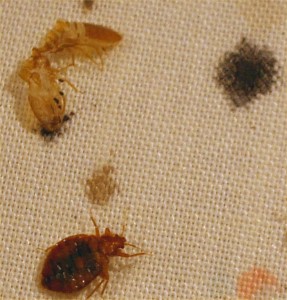Trusted DC Exterminator for Bed Bug Heat Treatment Near Me
Trusted DC Exterminator for Bed Bug Heat Treatment Near Me
Blog Article
Discovering the Science Behind Bed Insect Warmth Treatments as a Lasting Pest Administration Strategy
In the world of bug management, the pursuit for efficient and sustainable options remains a continuous pursuit. One such approach that has actually acquired grip in the last few years is the use of heat treatments to deal with bed insect invasions. By taking advantage of the science behind thermal fatality points for these relentless bugs, warm therapies provide a promising choice to traditional chemical-based approaches. The details of just how warm effectively eliminates bed pests and the wider ramifications for sustainable parasite monitoring practices make this a topic worth exploring further.
Bed Pest Warm Therapy Refine

Thermal Fatality Point for Bed Insects
Subjecting bed bugs to elevated temperatures beyond their thermal tolerance range is crucial for achieving effective obliteration in warm treatment procedures. The thermal fatality point for bed insects refers to the temperature at which these pests can not make it through. Research study shows that bed insects begin to perish when revealed to temperature levels over 113 ° F(45 ° C) for a continual period. As the temperature level boosts, so does the mortality rate of bed pests. At around 118 ° F(48 ° C ), bed insects start to die rapidly, with a mortality rate of almost 99% within mins of direct exposure. This demonstrates the sensitivity of bed insects to high temperatures and highlights the performance of warmth therapies in eliminating infestations. By reaching and preserving temperatures over the thermal fatality point for bed pests, pest monitoring professionals can make sure thorough elimination of bed insect populaces, including hard-to-reach locations where chemical treatments might be less reliable. Understanding the thermal fatality point for bed insects is crucial for applying successful warm therapy approaches and achieving lasting pest management results.
Benefits of Warm Treatments
Having established the crucial thermal fatality point for bed bugs, it is vital to now check out the substantial advantages that warmth treatments provide in effectively getting rid of these resilient parasites. Warm therapies present a number of vital advantages when contrasted to traditional chemical approaches. One of the primary benefits is that warmth can penetrate deep into crevices and splits where bed insects conceal, ensuring that also one of the most hard-to-reach areas are heated to dangerous temperatures. This comprehensive technique not only eliminates live bugs yet also targets bed insect eggs, protecting against future problems.
In addition, heat treatments are environmentally friendly and safe, making them a lasting pest monitoring strategy. Unlike chemical pesticides, warmth therapies do not leave damaging deposits that can pose threats to human wellness or the environment. This aspect is particularly vital in delicate environments such as medical facilities, schools, and property areas where chemical use might not be preferable.
Furthermore, warm therapies have a high success price in getting rid of bed pest invasions in a single treatment, lowering the need for numerous gos to and reducing disturbance to passengers. This efficiency not just saves time and money but additionally gives satisfaction to those dealing with bed insect problems.
Effectiveness of Heat Treatment

Heat therapies have actually the added advantage of killing bed bug eggs, which are frequently resistant to typical chemical therapies. On the whole, the effectiveness of heat therapies in web removing bed insect infestations makes them a trusted and sustainable parasite management strategy.
Lasting Parasite Administration Conveniences
Executing lasting parasite administration techniques supplies long-lasting advantages for both the atmosphere and public health and wellness. By utilizing methods such as heat therapies for bug control, we can minimize the dependence on harmful chemical pesticides that can have damaging impacts on ecosystems and human health - bed bug heat treatment. Lasting insect monitoring methods help in preserving biodiversity by targeting specific pests without hurting non-target microorganisms, consequently keeping a well balanced environment
Additionally, sustainable bug management techniques contribute to the general health and health of the general public. By minimizing exposure to poisonous chemicals used in conventional pest control methods, heat therapies give a more secure alternative for parasite management in residential, commercial, and public rooms. This reduction in chemical usage also helps in stopping chemical residues from polluting dirt, water, and air, guarding environmental quality.
Conclusion
In conclusion, bed insect heat therapies have been revealed to be a effective and lasting insect management approach. The thermal fatality point for bed bugs makes them prone to heat therapies, which have many benefits over typical chemical therapies. The effectiveness of warmth therapies in eliminating bed insect infestations while lessening ecological impact highlights the possibility of this approach as a sustainable remedy for parasite control.
The bed insect warmth therapy process involves increasing the temperature level within ravaged locations to a degree that effectively gets rid of bed pests and their eggs. By getting to and preserving temperature levels over the thermal death factor for bed bugs, pest administration professionals can guarantee comprehensive elimination of bed insect populaces, consisting of hard-to-reach locations where chemical therapies might be less effective. One of website link the key advantages is that warmth can penetrate deep into cracks and holes where bed insects hide, guaranteeing that even the most hard-to-reach locations are heated up to deadly temperatures. Unlike chemical therapies that might leave behind immune populaces, warmth therapies provide a safe and environmentally pleasant option that can penetrate deep right into furnishings, wall surfaces, and various other informative post hard-to-reach areas where bed bugs hide.
The thermal death point for bed pests makes them at risk to warmth treatments, which have numerous advantages over typical chemical therapies.
Report this page